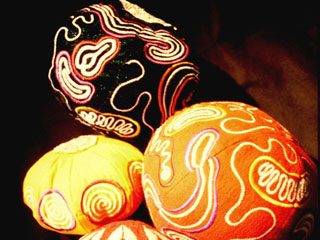Music Shapers |
Maggie Orth, Gili Weinberg | |
|
These are single-person, sophisticated hyperinstruments, designed for children and non-professional musicians. Part of a musical texture or fragment is provided by a computational system, and is then modified, personalized, or "shaped" by the player. Our first experiments in this area were with the still-successful Sensor Chair, which allows free-body gesture to control sound; and we have since been interested in more tactile, "squeezable" interfaces. Most musical interfaces today are hard and tough, from ivory piano keys to taut drum heads, to vibrating metallic violin strings. Sound itself and especially the vast sound world opened up by computers and synthesizers is noticeably malleable, multi-dimensional, and not rigid. We are developing a new generation of interfaces that can be squeezed, pulled, stretched, and twisted, with various degrees of suppleness. We are experimenting both with new materials and with multiple sensing devices to measure 3-D volume of stretched objects, as well as multiple points of force exertion. A wide range of materials are being explored, including foam balls, conductive fabrics and threads, and even stretchable media like Play-Doh. Such interfaces are proving to be useful for children and students, giving direct tactile control over complex sound systems, but will also be sophisticated enough for use by sophisticated musicians and music-lovers. |

|
|
|
[Home]
morth@media.mit.edu gili@media.mit.edu |
||